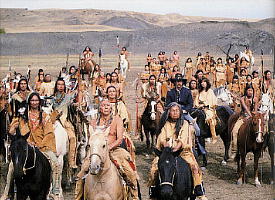Dancing with Dunbar (Hero or Villain?)
 Dances with Wolves probably has the best most authentic representation of Native American Indian lifestyle in the movies (along with Black Robe and The Fast Runner). The movie lasting three hours can take its time in showing a buffalo hunt, the women working on daily chores, gathering water, the taking down of the tepees. It also used Native American actors in most of the major roles and thankfully used the Sioux language instead of broken English. Dances with Wolves probably has the best most authentic representation of Native American Indian lifestyle in the movies (along with Black Robe and The Fast Runner). The movie lasting three hours can take its time in showing a buffalo hunt, the women working on daily chores, gathering water, the taking down of the tepees. It also used Native American actors in most of the major roles and thankfully used the Sioux language instead of broken English.
It also shows a very positive view of life among the Sioux, particularly in contrast to the white world. The world that Dunbar left was so crazy that he was willing to commit suicide to escape it. The commanding officer who gave him his orders did kill himself. Dunbar was really happy to leave "civilization". The camp he arrived at was a blight on the beautiful natural world.
As Dunbar comes to know the Sioux, he says "Nothing that I had been told about these people has been correct. They are not beggars and thieves. They are not the bogeyman that they are made out to be. On the contrary they are polite guests and have a familiar humor I enjoy." In this revisionist movie Costner is trying to dispel all the myths and stereotypes that had been perpetuated on Native Americans and he does a good job.
The movie has been criticized by some because even though it presents the Sioux in a positive light it shows another tribe as savage and barbaric. Looking at the Pawnees from within the closed world of the Sioux we are led to believe that they are evil. When we examine them more objectively we find they are actually presented in a noble fashion. The warrior played by Wes Studi is actually a brave warrior who attacks the Sioux with just a war club. He is shot in a cowardly manner by the Sioux with their newly acquired rifles.
If we are going to select a villain (besides the US Calvary) I would have to select Dunbar. It was he who equipped the Sioux with rifles, corrupting the way battles had been traditionally been fought between the two tribes. 'Even the old men could not remember such a one sided victory', Dunbar says in a voice over. With the introduction of firearms the traditional battles between the tribes escalated from largely ceremonial encounters to bloodbaths. Dunbar, like the white settlers that followed, helped destroy the Plains culture.
Dances with Wolves tried to show Native American culture in a positive light and I think it did that very successfully. It may have gone a little overboard in its portrayal of the negative aspects of the invading 'white' culture. It tried to throw in two positive white portrayals, Stands with a Fist, who had taken on the Lakota way and Dunbar who had a rebirth after his near death experience.
Dunbar's rebirth was not enough, he was too corrupted to begin with. When his Indian friends had troubles he thought that bringing the white man's technology in could help them. He should have left that technology buried. This modern day Prometheus was no heroic character. He was the personification of those whites who later came and tried to 'help' the Indians by making them more like us. If you look at Dances with Wolves from the perspective of having Dunbar as the villain and the destroyer of the native culture, it becomes a very profound and rewarding movie.
|

